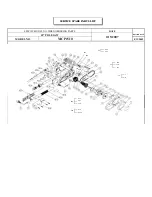
EN
ENGLISH
36
Safety instructions for table and mitre
saws
Wear suitable personal protection equipment.
Hearing protection to minimise the risk of becoming
hard of hearing.
Wear eye protective goggles !
Respiratory protection to minimise the risk of inhaling
harmful dust.
Connect the device to a dust collection device when
sawing wood.
Wear gloves when handling saw blades and rough
materials.
Carry the saw blades in a container whenever this is
feasible.
Wear sturdy, non-slip footwear.
Safety precautions
Do not use saw blades which are damaged or defor-
med Only use saw blades which have been properly
sharpened.
Please note the instructions on correctly changing
and aligning the saw blade, including the details on
how to return the protective devices to their proper
position in tabletop circular saw and mitre saw mode.
Replace the table insert when worn
Only use saw blades recommended by the manufac-
turer.
The splitter may be no thicker than the kerf width and
no thinner than the base body of the saw blade.
Saw blades for wood working must comply with EN
847-1. Do not use saw blades made of high-speed
steel.
Safe working
In tabletop circular saw mode use a push rod or a
push block with a handle to make sure that hands do
not get too close to the saw blade during operation.
Return the push rod to its holder when not in use.
Do not carry the device by the protective device,
instead, use the equipment provided for this purpose.
The upper part of the saw blade must be covered
during transport e.g. by the upper protective cover or
by setting the saw blade in its lowest position.
Keep the floor area free of loose material e.g. chips
and cut-offs.
The operator must be adequately trained in how to
use, set and operate the machine.
Make sure that the arm is securely fastened when
cutting at an angle.
Make sure that the arm is securely fastened in table-
top circular saw mode.
Switch-off the device when leaving the workstation.
Make sure that the tabletop circular saw table is
securely fastened at the selected height.
The rated speed of the accessory must be at least
equal to the maximum speed marked on the power
tool.
Make sure to use only spacer discs and spindle rings
that are suitable for the purpose specified by the
manufacturer.
The upper part of the saw blade must be fully enc-
losed in mitre saw mode.
Do not remove off-cuts or other parts of the workpie-
ce while the machine is running with an unprotected
saw blade.
Never reach into the danger area of the machine
when it is running.
Make sure that the splitter is properly set in tabletop
circular saw mode.
Use the required safety devices when sawing notches
and grooves in tabletop circular saw mode.
The machine may not be used for plunge cutting.
Select the speed depending the various materials to
be processed.
Make sure that the lower saw protective device is
used and is properly set in tabletop circular saw
mode.
Always clamp the workpiece to the sawing table in
mitre saw mode.
Ensure that the machine is stable before every sawing
process.
Fasten the machine to a workbench or similar, if
required.
If you have workpieces that are wider or longer than
the tabletop, provide appropriate support e.g. with
table extensions or sawhorses.
When performing mitre, bevel or compound mitre
cuts, adjust the sliding fence to ensure the correct
clearance from the blade.
The saw may only be used when the protective equip-
ment is functioning properly, in good condition and
in the correct position.
Make sure that the saw is properly set-up in tabletop
circular saw or mitre saw mode respectively.
Risk of injury!
Keep body parts and clothes away from rotating
parts of the device.
Carry out a visual inspection before switching the
appliance on.
Check especially the safety equipment, electrical
control elements, power lines and screw couplings for
any damage and if they are tightened appropriately. If
necessary, replace damaged parts before operation.
In the event of a blockage, switch off the machine
immediately. Pull out the mains plug and remove the
jammed workpiece.
Mains Connection
Operation is only allowed with a safety
switch against stray current (RCD max. stray
current of 30mA).
















































